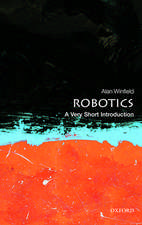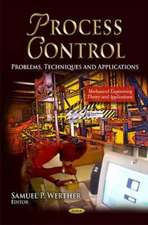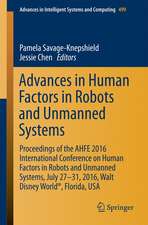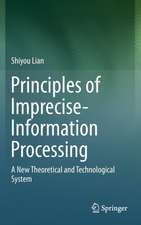Motion Understanding: Robot and Human Vision: The Springer International Series in Engineering and Computer Science, cartea 44
Editat de W. Bach, J.K. Aggarwalen Limba Engleză Hardback – 29 feb 1988
| Toate formatele și edițiile | Preț | Express |
|---|---|---|
| Paperback (1) | 1047.46 lei 38-44 zile | |
| Springer Us – 17 sep 2011 | 1047.46 lei 38-44 zile | |
| Hardback (1) | 1230.66 lei 6-8 săpt. | |
| Springer Us – 29 feb 1988 | 1230.66 lei 6-8 săpt. |
Din seria The Springer International Series in Engineering and Computer Science
- 24%
 Preț: 1041.98 lei
Preț: 1041.98 lei - 20%
 Preț: 643.50 lei
Preț: 643.50 lei - 18%
 Preț: 1225.62 lei
Preț: 1225.62 lei - 18%
 Preț: 965.02 lei
Preț: 965.02 lei - 20%
 Preț: 646.12 lei
Preț: 646.12 lei - 18%
 Preț: 948.79 lei
Preț: 948.79 lei - 20%
 Preț: 646.62 lei
Preț: 646.62 lei - 15%
 Preț: 637.46 lei
Preț: 637.46 lei - 20%
 Preț: 643.83 lei
Preț: 643.83 lei - 18%
 Preț: 949.23 lei
Preț: 949.23 lei - 20%
 Preț: 644.48 lei
Preț: 644.48 lei - 20%
 Preț: 994.92 lei
Preț: 994.92 lei - 20%
 Preț: 645.97 lei
Preț: 645.97 lei - 18%
 Preț: 946.87 lei
Preț: 946.87 lei - 20%
 Preț: 995.57 lei
Preț: 995.57 lei - 18%
 Preț: 956.99 lei
Preț: 956.99 lei - 20%
 Preț: 644.98 lei
Preț: 644.98 lei - 15%
 Preț: 649.54 lei
Preț: 649.54 lei - 18%
 Preț: 950.21 lei
Preț: 950.21 lei - 18%
 Preț: 1221.38 lei
Preț: 1221.38 lei - 18%
 Preț: 957.62 lei
Preț: 957.62 lei - 15%
 Preț: 643.99 lei
Preț: 643.99 lei - 18%
 Preț: 948.47 lei
Preț: 948.47 lei - 18%
 Preț: 947.35 lei
Preț: 947.35 lei - 20%
 Preț: 1284.65 lei
Preț: 1284.65 lei - 20%
 Preț: 1628.31 lei
Preț: 1628.31 lei - 20%
 Preț: 1285.78 lei
Preț: 1285.78 lei
Preț: 1230.66 lei
Preț vechi: 1500.81 lei
-18% Nou
Puncte Express: 1846
Preț estimativ în valută:
235.51€ • 255.73$ • 197.83£
235.51€ • 255.73$ • 197.83£
Carte tipărită la comandă
Livrare economică 22 aprilie-06 mai
Preluare comenzi: 021 569.72.76
Specificații
ISBN-13: 9780898382587
ISBN-10: 0898382580
Pagini: 432
Ilustrații: XXIV, 432 p.
Dimensiuni: 155 x 235 x 25 mm
Greutate: 0.82 kg
Ediția:1988
Editura: Springer Us
Colecția Springer
Seria The Springer International Series in Engineering and Computer Science
Locul publicării:New York, NY, United States
ISBN-10: 0898382580
Pagini: 432
Ilustrații: XXIV, 432 p.
Dimensiuni: 155 x 235 x 25 mm
Greutate: 0.82 kg
Ediția:1988
Editura: Springer Us
Colecția Springer
Seria The Springer International Series in Engineering and Computer Science
Locul publicării:New York, NY, United States
Public țintă
ResearchCuprins
1 Bounding Constraint Propagation for Optical Flow Estimation.- 1.1 Introduction.- 1.2 The Gradient Constraint Equation.- 1.3 Gradient-Based Algorithms.- 1.4 Coping with Smoothness Violations.- 1.5 Results.- 1.6 Discussion.- 2 Image Flow: Fundamentals and Algorithms.- 2.1 Introduction.- 2.2 Simple Image Flows.- 2.3 Discontinuous Image Flow.- 2.4 Analysis of Discontinuous Image Flows.- 2.5 Algorithms for Discontinuous Image Flows.- 2.6 Smoothing Discontinuous Image Flows.- 2.7 Summary and Conclusions.- 3 A Computational Approach to the Fusion of Stereopsis and Kineopsis.- 3.1 Introduction.- 3.2 Integrating Optical Flow to Stereopsis for Motion.- 3.3 Perception of Rigid Objects in Motion.- 3.4 Examples.- 3.5 Summary.- 4 The Empirical Study of Structure from Motion.- 4.1 Introduction.- 4.2 Viewer-Centered vs. Object-Centered Depth.- 4.3 The Correspondence Problem.- 4.4 Rigidity.- 4.5 Perception of Self Motion.- 4.6 A Theory of Observers.- 4.7 An Empirical Test of Constraints.- 4.8 Summary and Conclusions.- 5 Motion Estimation Using More Than Two Images.- 5.1 Introduction.- 5.2 General Description of the Method.- 5.3 Results.- 5.4 Comparison with Other Methods.- 5.5 Conclusions.- 6 An Experimental Investigation of Estimation Approaches for Optical Flow Fields.- 6.1 Introduction.- 6.2 Feature Based Estimation.- 6.3 Analytical Approach for the Estimation of Optical Flow Vector Fields.- 6.4 Discussion.- 7 The Incremental Rigidity Scheme and Long-Range Motion Correspondence.- 7.1 The Rigidity-Based Recovery of Structure from Motion.- 7.2 The Incremental Rigidity Scheme.- 7.3 Experimental Results.- 7.4 Additional Properties of the Incremental Rigidity Scheme.- 7.5 Possible Implications to the Long-Range Motion Correspondence Process.- 7.6 Summary.- 8 Some Problems with Correspondence.- 8.1 Introduction.- 8.2 Determining Correspondence.- 8.3 Correspondence in Computer Vision.- 8.4 An Experiment on Correspondence.- 8.5 Conclusions.- 9 Recovering Connectivity from Moving Point-Light Displays.- 9.1 Introduction.- 9.2 Motion Information is a Minimal Stimulus Condition for the Perception of Form.- 9.3 Processing Models for Recovering Form from Motion.- 9.4 Do Fixed-Axis Models Predict Human Performance?.- 9.5 Human Implementation of Additional Processing Constraints.- 9.6 Incompatibilities Between Human Performance and Models Seeking Local Rigidity.- 9.7 Conclusion.- 10 Algorithms for Motion Estimation Based on Three-Dimensional Correspondences.- 10.1 Introduction.- 10.2 Direct Linear Method.- 10.3 Method Based on Translation Invariants.- 10.4 Axis-Angle Method.- 10.5 The Screw Decomposition Method.- 10.6 Improved Motion Estimation Algorithms.- 10.7 Comparing the Linear and Nonlinear Methods.- 10.8 Simulation Results for Three-Point Methods.- 10.9 Some Recent Related Results.- 11 Towards a Theory of Motion Understanding in Man and Machine.- 11.1 Introduction.- 11.2 The Time Complexity of Visual Perception.- 11.3 Measurement and Hierarchical Representations in Early Vision.- 11.4 Biological Research.- 11.5 Machine Research.- Author Index.



















